Sustainability, from science to philosophy to lifestyle, expresses how we shape our cities. Cities are not just a collection of structures but groups of people living different lifestyles together. When we ask if a lifestyle is sustainable, we ask if it can endure. Some archaeologists posit that environmental imbalance doomed many failed ancient civilizations. What could a sustainable city look like, how would it function, and how can we avoid an imbalance that will lead to the collapse of our material civilization?
Throughout history, settlement patterns have been set by technology and commerce. Civilizations have produced food, clothing, and shelter and accessed foreign markets to purchase and sell goods. Workers traditionally had to live near their occupation, although, in modern industrial times, advanced transportation systems have enabled us to live quite a distance from where we work.
In hindsight, we can see how reliance on water and horse-drawn transportation shaped historical civilizations and how this equation was radically altered with the rise of the automobile following World War II. While attempting to envision the “Sustainable City,” we must discern what factors will influence its shape and form in the future.
Green Urbanism and Sustainable Cities
Green urbanism is a conceptual model that seeks to transform and re-engineer existing city districts and regenerate the post-industrial city center. It promotes the development of socially and environmentally sustainable city districts. The following principles of green urbanism (Figure 1) offer practical steps toward sustainable cities, harmonizing growth and usage of resources.
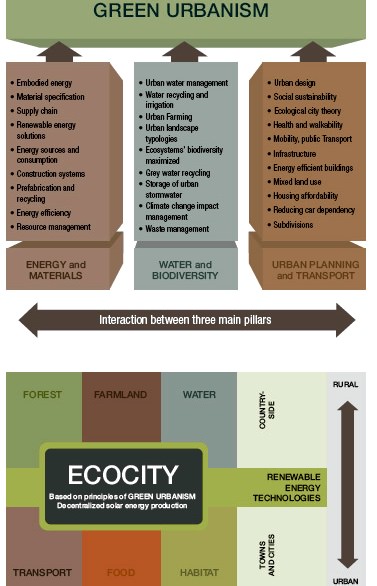
Climate and Context
Every site or place has unique conditions regarding orientation, solar radiation, rain, humidity, prevailing wind direction, topography, shading, lighting, noise, air pollution, and so on. The various aspects of this principle include Climatic conditions, which are seen as the fundamental influence for form generation in the design of any project; understanding the site and its context, which is essential at the beginning of every sustainable design project; optimizing orientation and compactness to help reduce the city district’s heat gain or losses; achieving a city with minimized environmental footprint by working with the existing landscape, topography, and resources particular to the site, and the existing micro-climate of the immediate surroundings. Maintaining complexity in the system is always desirable (be it biodiversity, eco-system, or neighborhood layout), and a high degree of complexity is always beneficial for society. Enhancing the opportunities offered by topography and natural setting leads to a city well adapted to the local climate and its eco-system. We can use the buildings’ envelope to filter temperature, humidity, light, wind, and noise. Due to the different characteristics of every location, each city district has to develop its own methods and tailored strategies to reach sustainability and capture the spirit of the place. Each site or city is different, and the drivers for re-engineering existing districts will need to understand how to take full advantage of each location’s potential and fine-tune the design concept to take advantage of local circumstances. As an aim, all urban development must be in harmony with each location’s specific characteristics, various site factors, and advantages and be appropriate to its societal setting and contexts (cultural, historical, social, geographical, economical, environmental, and political). In the future, all buildings should have climate-adapted envelope technologies with fully climate-responsive facades.
Renewable Energy for Zero CO2 Emissions
The various aspects of this principle include: Energy supply systems and services, as well as energy-efficient use and operation, promoting increased use of renewable power, and perhaps natural gas as a transition fuel in the energy mix, but always moving quickly away from heavy fossil fuels such as coal and oil; and the transformation of the city district from an energy consumer to an energy producer, with local solutions for renewables and the increasing de-carbonizing of the energy supply. The oil supply will last shorter than the life expectancy of most buildings. The local availability of a renewable energy source is the first selection criteria for deciding on energy generation. Generally, a well-balanced combination of energy sources can sensibly secure future supply. A necessary aim is to have a distributed energy supply through a decentralized system, utilizing local renewable energy sources. This will transform city districts into local power stations of renewable energy sources, including solar PV, solar thermal, wind (on- and off-shore), biomass, geothermal power, mini-hydro energy, and other new technologies. The most promising technologies are building-integrated PV, urban wind turbines, micro CHP, and solar cooling. That is to say, there should be on-site electrical generation and energy storage in combination with a smart grid, which integrates local solar and wind generation, utilizing energy efficiency in all its forms. Solar hot water systems would be compulsory. Cogeneration technology utilizes waste heat through CHP combined-heat-and-power plants. Energy-efficiency programs are not enough. Too often, we find that a rise in energy use absorbs savings from energy efficiency programs. Genuine action on climate change means that coal-fired power stations cease to operate and are replaced by renewable energy sources. Eco-districts will need to operate on renewable energy sources as close to 100 percent as possible. At least 50 percent of on-site renewable energy generation should be the aim of all urban planning, where the energy mix comes from decentralized energy generation and takes into account the locally available resources, as well as the cost and availability of the technology. The energy balance can be optimized using exchange, storage, and cascading (exergy) principles. Therefore, the fossil-fuel-powered energy and transportation systems currently supporting our cities must be rapidly turned into systems supplied by renewable energy sources. High building insulation, high energy-efficiency standards, and smart metering technology are essential. If a part of an office building is not in use, the intelligent building management system will shut down lights and ventilation.
Zero-Waste
Sustainable waste management means turning waste into a resource. All cities should adopt nature’s zero-waste management system. Zero-waste urban planning includes reducing, recycling, reusing, and composting waste to produce energy. All material flows need to be examined and fully understood, and special attention needs to be given to industrial waste and e-waste treatment. We need to plan for recycling centers, zero landfill, and ‘eliminating the concept of waste’ and better understand nutrient flows. Ecodistricts are neighborhoods where we reuse and recycle materials and significantly reduce the volume of solid waste and toxic chemical releases. All construction materials and the production of goods (and building components) need to be healthy and fully recyclable.
Waste prevention is always better than the treatment or cleaning up after waste is formed. Some other systems that need to be put in place are: the remanufacturing of metals, glass, plastics, and paper into new products needs to be a routine (without down-grading the product); waste-to-energy strategies are needed for residual waste; and an `extended producer responsibility’ clause is needed for all products. In this context of waste, better management of the nitrogen cycle has emerged as an important topic: to restore the balance to the nitrogen cycle by developing improved fertilization technologies and technologies in capturing and recycling waste. Controlling agriculture’s impact on the global nitrogen cycle is a growing challenge for sustainable development. Essentially, we need to become (again) a recycling society, where it is common that around 60 to 90 percent of all waste is recycled and composted.
Water
The various aspects of this principle include, in general, reducing water consumption, finding more efficient uses for water resources, ensuring good water quality, and the protection of aquatic habitats. The city can be used as a water catchment area by education using wastewater recycling and stormwater harvesting techniques. Stormwater and flood management concepts need to be adopted as part of the urban design, including stormwater run-offs, improved drainage systems, and wastewater treatment (Figure 2).

As part of the eco-districts, adequate and affordable health care provisions must ensure safe water and sanitation supply. This includes algae and biofiltration systems for grey water and improving the quality of our rivers and lakes so they are fishable and swimmable again. An integrated urban water cycle planning and management system that includes a high-performance infrastructure for sewage recycling (grey and black water recycling), stormwater retention, and harvesting the substantial run-off through storage must be routine in all design projects. On a household level, we need to collect rainwater and use it sparingly for washing and installing dual-water systems and low-flush toilets. On a food production level, we need to investigate the development of crops that need less water and are more drought resistant.
Landscape, Gardens, and Urban Biodiversity
A sustainable city takes pride in its many beautiful parks and public gardens (Figure 3). This pride is best formed through a strong focus on local biodiversity, habitat and ecology, wildlife rehabilitation, forest conservation, and the protection of regional characteristics. Ready access to these green spaces (Figure 4): public parks and gardens, with opportunities for leisure and recreation, are essential components of a healthy city, as is arresting the loss of biodiversity by enhancing the natural environment and landscape and planning the city using ecological principles based on natural cycles (not on energy-intensive technology) as a guide, and increasing urban vegetation. A city that preserves and maximizes its open spaces, natural landscapes, and recreational opportunities is more healthy and resilient. The sustainable city must also introduce inner-city gardens, urban farming, and green roofs in all its urban design projects (using the city for food supply).
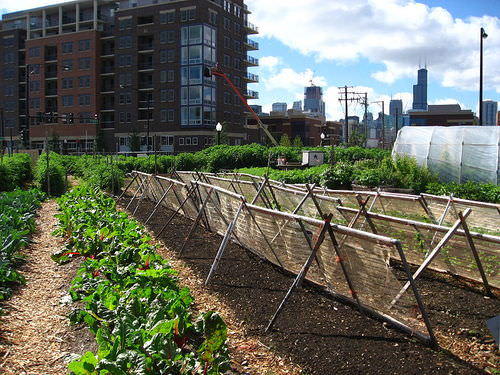
It needs to maximize the resilience of the ecosystem through urban landscapes that mitigate the `urban heat island’ (UHI) effect, using plants for air purification and urban cooling. Further, narrowing roads, which calms traffic and lowers the UHI effect, allows for more (all-important) tree planting. Preserving green space, gardens, and farmland, maintaining a green belt around the city, and planting trees everywhere (including golf courses), as trees absorb CO2, is an important mission.
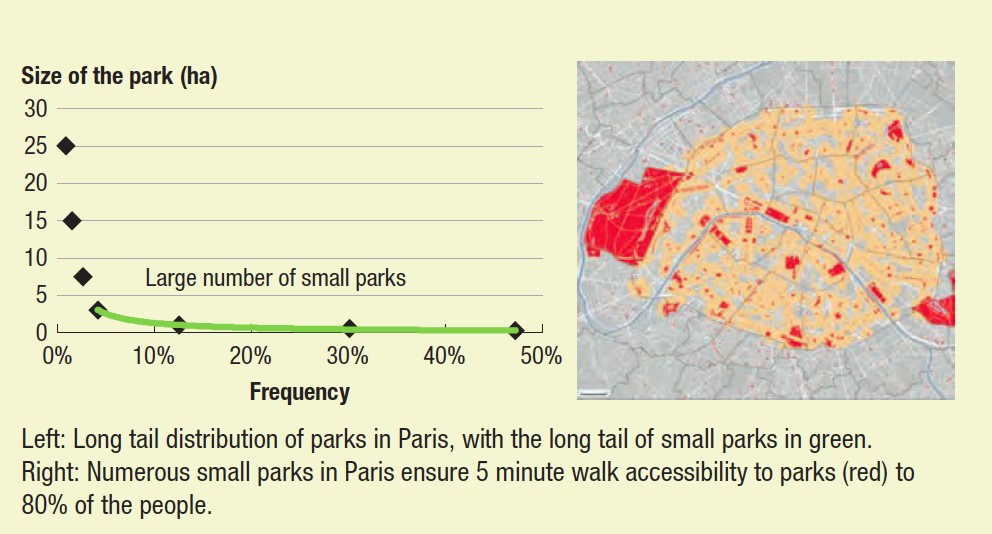
As is conserving natural resources, respecting natural energy streams, and restoring stream and river banks, maximizing species diversity. At home, we need to de-pave the driveway or tear up parking lots. In all urban planning, we need to maintain and protect the existing ecosystem that stores carbon (e.g., through a grove or a park) and plans to create new carbon storage sites by increasing the amount of tree planting in all projects. The increase in the percentage of green space as a share of total city land will be combined with densification activities.
Sustainable Transport and Good Public Space: Compact and Poly-Centric Cities
Good access to basic transport services is crucial, as it helps to reduce automobile dependency, as does reducing the need to travel. We need to see integrated non-motorized transport, such as cycling or walking, and, consequently, bicycle/pedestrian-friendly environments with safe bicycle ways, free rental bike schemes, and pleasant public spaces. Identifying the optimal transport mix that offers interconnections for public transport and integrating private and public transport systems is important.
Some ideas include eco-mobility concepts and smart infrastructure (electric vehicles), integrated transport systems (bus transit, light railway, bike stations), improved public space networks and connectivity, and a focus on transport-oriented development. It is a fact that more and wider roads result in more car and truck traffic and CO emissions. Also, it allows for sprawling development and suburbs that increase electricity demand and provides less green space. The transport sector is responsible for causing significant greenhouse-gas emissions (over 20 percent). To combat this effect, we need to change our lifestyles by, for example, taking public transport, driving the car less, or car-pooling. Alternatively, we can bike or walk if the city district has been designed for it. Personal arrangements have the potential to reduce commuting and boost community spirit. We want a well-connected city district for pedestrians, a city with streetscapes that encourage a healthy, active lifestyle, and where residents travel less and less by car.
Density and Retrofitting of Existing Districts
The various aspects of this principle include: encouraging the densification of the city center through mixed-use urban infill (Figure 5), center regeneration and green transit-oriented development (TOD); increasing sustainability through density and compactness; promoting business opportunities around green transit-oriented developments; optimizing the relationship between urban planning and transport systems; retrofitting inefficient building stock and systematically reducing the city district’s carbon footprint.
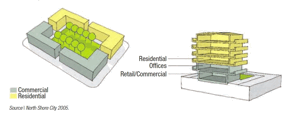
Consideration will need to be given to better land-use planning to reduce the impact of urban areas on agricultural land and landscape; to increase urban resilience by transforming city districts into more compact communities and designing flexible typologies for inner-city living and working. Special strategies for large metropolitan areas and fast-growing cities are required. Here, examples of rapid development are being provided by Asian cities. Special strategies are also needed for small and medium-sized towns due to their particular milieu, and creative concepts are needed for the particular vulnerabilities of Small Island States and coastal cities. Public space upgrading through urban renewal programs will bring people back to the city center. This will need some strategic thinking about using brownfield and greyfield developments and the adaptive reuse of existing buildings. Remodeling and re-energizing existing city centers to bring about diverse and vibrant communities requires people to move back into downtown areas. This can be achieved through mixed-use urban infill projects, building the “city above the city” by converting low-density districts into higher-density communities and revitalizing underutilized land for community benefit and affordable housing.
Green Buildings and Districts, Using Passive Solar Design Principles
The various aspects of this principle include low-energy, zero-emission designs, applying best practices for passive solar design principles (Figure 6) for all buildings and groups of buildings; dramatically reducing building energy use, introducing compact solar architecture, and renovating and retrofitting the entire building stock. New design typologies need to be developed at a low cost, and we need to produce functionally neutral buildings that last longer.
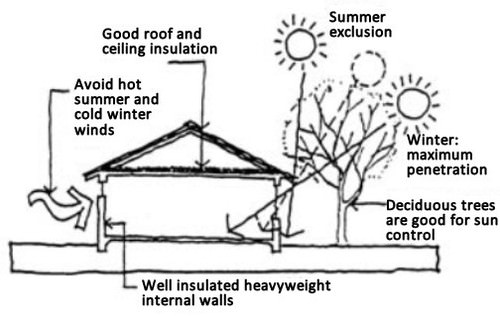
We need to apply facade technology with responsive building skins for bio-climatic architecture to take advantage of cooling breezes and natural cross-ventilation, maximizing cross-ventilation, day-lighting, and opportunities for night-flush cooling; we need to focus on the low consumption of resources and materials, including the reuse of building elements and design for disassembly. Other ideas include mixed-use concepts for compact housing typologies; adaptive reuse projects that rejuvenate mature estates; solar architecture that optimizes solar gain in winter and sun shading technology for summer, catching the low winter sun and avoiding too much heat gain in summer. It is important to renew the city with energy-efficient green architecture, creating more flexible buildings of long-term value and longevity. Flexibility in a plan leads to a longer life for buildings. Technical systems and services have a shorter life cycle. First, this means applying technical aids sparingly and making the most of all passive means provided by the building fabric and natural conditions. Buildings that generate more energy than they consume, and collect and purify their own water, are achievable. We need to acknowledge that the city as a whole is more important than any individual building.
Local and Sustainable Materials with Less Embodied Energy
The various aspects of this principle include advanced materials technologies, using opportunities for shorter supply chains, where all urban designs focus on local materials and technological know-how, such as regional timber in common use. Affordable housing can be achieved through modular prefabrication. Prefabrication (Box below) has come and gone several times in modern architecture. Still, this time, with closer collaboration with manufacturers of construction systems and building components in the design phase, the focus will be sustainability. We need to support innovation and be aware of sustainable production and consumption, the embodied energy of materials, and energy flow in closing life cycles. We must emphasize green manufacturing and an economy of means, such as process-integrated technologies that reduce waste. Using lightweight structures, enclosures, and local materials with less embodied energy is more environmentally friendly, requiring minimal transport. We need improved material and system specifications, supported by research in new materials and technological innovation, and reduced material diversity in multi-component products to help facilitate the design for resource recovery, disassembly, value retention, and the possibility of reusing entire building components. Success in this area will increase the long-term durability of buildings, reduce waste and minimize packaging.
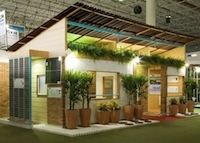
Livability, Healthy Communities, and Mixed-Use Programs
Land use development patterns are the key to sustainability. A mixed-use (and mixed-income) city delivers more social sustainability and inclusion and helps repopulate the city center. Demographic changes, such as age, are a major issue for urban design. It is advantageous for any project to maximize the diversity of its users. Different sectors in the city can take on different roles over a 24-hour cycle; for example, the Central Business District is used for more than just office work. In general, we want connectivity (Figure 8), compact communities for a livable city, applying mixed-use concepts and strategies for housing affordability, and offering different typologies for housing needs.
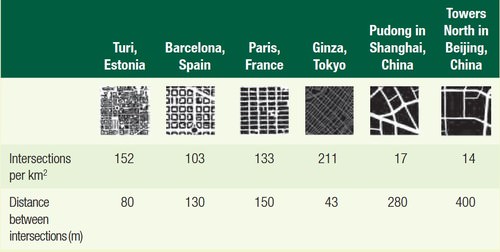
To this end, we need affordable and livable housing and new flexible typologies for inner-city living. These mixed-use neighborhoods (of housing types, prices, and ownership forms) have to avoid gentrification and provide affordable housing with districts inclusive for the poor and the rich, young and old, and workers of all walks of life, and also provide secure tenure (ensuring ‘aging in place’). Mixed land uses are particularly important as it helps reduce traffic. Master plans should require all private developments to contain 40 to 50 percent of public (social) housing and integrate it with private housing. Higher densities should center on green TODs. These changes will introduce more sustainable lifestyles, with jobs, retail, housing, and a city campus nearby. IT and telecommuting (Figure 9) from home significantly help reduce travel.

By integrating a diverse range of economic and cultural activities, we avoid mono-functional projects, which generate a higher demand for mobility. Green businesses would be supported through ethical investments to generate funding.
Local Food and Short Supply Chains
The various aspects of this principle include local food production; regional supply; an emphasis on urban farming and agriculture, including `eat local’ and `slow food’ initiatives. The sustainable city provides adequate land for food production, a return to the community, and the allotment gardens of past days, where roof gardens become an urban market. We must bridge the urban-rural disconnect and move cities towards models that deal with natural ecosystems and healthy food systems.
The people of the eco-city would garden and farm locally, sharing food, creating compost with kitchen scraps and garden clippings, and growing `community’ vegetables. Buying and consuming locally will be necessary to cut down on petrol-based transport. Such things as reusing bags and glass containers, paper recycling, and the cost of food processing will need reconsideration. We will need to reduce our consumption of meat and other animal products, especially shipped-in beef, as the meat cycle is very intensive in energy and water consumption, and herds create methane and demand great quantities of electricity. Perhaps as much as 50 percent of our food will need to be organically produced, without using fertilizers or pesticides made from oil, and grown in local allotments.
Cultural Heritages, Identity, and Sense of Place
All sustainable cities aim for air quality, health, and pollution reduction, to foster resilient communities, and to have strong public space networks and modern community facilities. This is the nature of sustainable cities. However, each city has its own distinct environment, whether by the sea, a river, in a desert, or a mountain; whether its climate is tropical, arid, temperate, etc., each situation is unique. The city’s design will consider all these factors, including materials, history, and population desires. The essence of a place is the up-swelling of grassroots strategies, the protection of its built heritage, and the maintenance of a distinct cultural identity, e.g., by promoting locally owned businesses and supporting creativity and cultural development. New ideas require affordable and flexible studio space in historic buildings and warehouses. Cities will grow according to the details and unique qualities of localities, the demographic qualities of the populace, and the creativity of the authorities and citizens. A city aims to support its residents’ health, activities, and safety. It is, therefore, incumbent on city councils to protect the city by developing a master plan that balances heritage with conservation and development, fostering distinctive places with a strong sense of place, where densities are high enough to support basic public transit and walk-to retail services.
Urban Governance, Leadership, and Best Practice
Good urban governance is extremely important to transform existing cities into sustainable compact communities. It has to provide efficient public transport, good public space and affordable housing, and high urban management standards; change will not happen without political support. City councils need strong management and political support to realize their urban visions. They need strong support for a strategic direction to manage sustainability through coherent combined management and governance approaches, which include evolutionary and adaptive policies linked to a balanced review process, and to help public authorities overcome their unsustainable consumption practices and change their methods of urban decision-making. A city that leads and designs holistically that implements change harmoniously, and where decision-making and responsibility are shared with the empowered citizenry is a city that is on the road to sustainable practices. In balancing community needs with development, public consultation exercises and grassroots participation are essential to ensuring people are sensitive to urban design and to encouraging community participation. Citizens need to participate in community actions aimed at governments and big corporations by writing letters and attending city-council hearings. Empowering and enabling people to be actively involved in shaping their community and urban environment is one of the hallmarks of a democracy. Cities are a collective responsibility. As far as bureaucratic urban governance and best practice is concerned, and authorities could consider many of the following: updating building code and regulations; creating a database of best practices and worldwide policies for eco-cities; revising contracts for construction projects and integrating public management; raising public awareness; improving planning participation and policy-making; creating sustainable subdivisions, implementing anti-sprawl land-use and growth boundary policies; legislating for controls in density and supporting high-quality densification; arriving at a political decision to adopt the Principles of Green Urbanism based on an integrated Action Plan; measures to finance a low-to-no-carbon pathway; implementing environmental emergency management; introducing a program of incentives, subsidies, and tax exemptions for sustainable projects that foster green jobs; eliminating fossil-fuel subsidies; developing mechanisms for incentives to accelerate renewable energy take-up; implementing integrated land-use planning; having a sustainability assessment and certification of urban development projects.
Education, Research, and Knowledge
The various aspects of this principle include technical training and up-skilling, research, exchange of experiences, and knowledge dissemination through research publications about ecological city theory and sustainable design. Primary and secondary teaching programs need to be developed for students in such subjects as waste recycling, water efficiency, and sustainable behavior. Changes in attitude and personal lifestyles will be necessary. The city is a hub of institutions, such as galleries, libraries, and museums, where knowledge can be shared. We must provide sufficient access to educational opportunities and training for the citizenry, thus increasing their chances of finding green jobs. Universities can act as `think tanks’ for transforming their cities. We also need to redefine the education of architects, urban designers, planners, and landscape architects. Research centers for sustainable urban development policies and best practices in eco-city planning could be founded, where assessment tools to measure environmental performance are developed, and local building capacity is studied.
Strategies for Cities in Developing Countries
Developing and emerging countries have their needs and require particular strategies, appropriate technology transfers, and funding mechanisms. Cities in the developing world cannot have the same strategies and debates as cities in the developed world. Similarly, particular strategies for emerging economies and fast-growing cities are required, as is the problem of informal settlements and urban slums and slum upgrading programs. Cooperation with poverty reduction programs, low-cost buildings, and mass housing typologies for rapid urbanization is required. We must train local people to empower communities, create new jobs, and diversify job structures to not focus on only one segment of the economy (e.g., tourism). Achieving more sustainable growth for Asian metropolitan cities is a necessity. Combating climate change, mainly caused by the emissions by industrialized nations and which is having its worst effect in poorer countries in Africa, Asia, and Latin America, with a focus on the Small Island States, is a priority.

